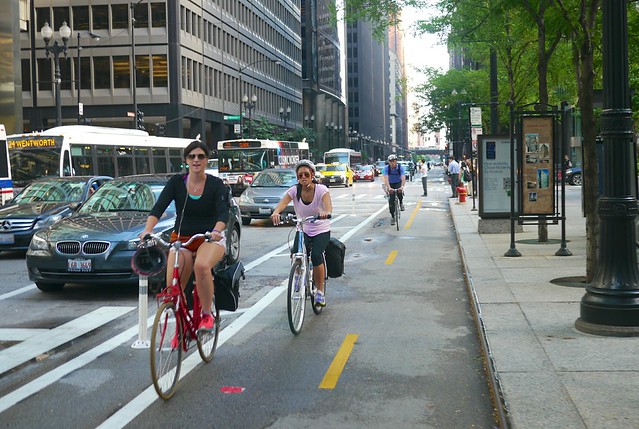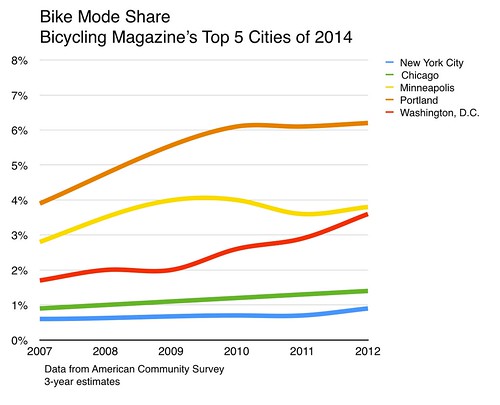When I heard that Bicycling Magazine gave Chicago second place in its “America’s Best Bike Cities” ratings, just behind New York and two slots above Portland, I was puzzled. However, I’m starting to warm up to the idea that our city and NYC deserve credit for taking bold action to improve cycling.
Few people would argue that Chicago, where dangerous driving and torn-up pavement are commonplace, is currently a more pleasant place to cycle than Portland, which fell to fourth place from its top ranking in 2012. Plus, our bike commute mode share -- the percentage of trips to work made by bicycle -- is only 1.3 percent, according to the U.S. Census Bureau's 2012 American Community Survey. That's less than a quarter of the Rose City’s 6.1 percent.
New York’s 2012 mode share was even less than ours, at only one percent. Minneapolis, with a mode share of 3.8 percent, took third place this year -- down a notch from second in Bicycling’s 2012 rankings. Washington, D.C., whose mode share was 3.6 percent, dropped from fourth place to fifth. Chicago was in fifth place last time.
These kinds of magazine ratings largely exist to boost newsstand sales, and Bicycling’s current rankings shake-up has already succeeded in garnering plenty of ink from other publications. One could argue that the Best Bike Cities ratings are arbitrary, and a little silly, but they do have a purpose. They create competition between the leading cities, and encourage less bike-friendly towns to improve. For example, Atlanta Mayor Kasim Reed has made cracking Bicycling’s top-ten rankings a signature goal.
Rahm Emanuel has taken notice of the new ratings. “Chicago is a national leader in building new and improved cycling facilities, and we are setting a new standard for other cities to follow,” he said in a statement today. “This new ranking by Bicycling Magazine demonstrates that Chicago is on the right path to becoming the best cycling city in America.”
Frankly, I was a little disappointed by this relatively humble response from the mayor who bragged two years ago that he planned to take all of Seattle’s bikers and tech jobs. Since the Emerald City came in at eighth place this year, Emanuel missed a chance to razz his former deputy transportation chief Scott Kubly, who recently defected to become Seattle's commissioner.
While Bicycling’s rankings are subjective, they do have some quantitative backbone. New York and Chicago got credit for having steadily rising rates of bike commuting. Between 2000 and 2012, Chicago’s mode share rose more than 150 percent, from 0.5 percent to 1.3 percent, according to a recent U.S. Census Bureau survey, while Portland and Minneapolis’ mode shares have leveled off in recent years. The 2013 Census estimates, due later this month, are likely to show further improvement in Chicago and NYC.
The top two cities also got credit for engaging in “a bike-sharing arms race.” New York currently has 6,000 Citi Bike cycles, while Chicago has 3,000 Divvy bikes and plans to expand to 4,750 next year. However, the city of Chicago recently boasted that, once it expands to 475 docking stations, Divvy will have the largest number of stations and the widest coverage area of any North American city.
The magazine also gave New York and Chicago points for physically protected bike lanes. NYC installed 31 miles of PBLs under the Bloomberg administration, and Chicago has put in 16.5 miles of protected lanes as part of Emanuel’s goal of reaching 100 miles of buffered and protected lanes in his first term. He announced today that another 49 miles of BBLs and PBLs are currently in the design phase and will be constructed this fall and in 2015.
Bicycling applauded Chicago for breaking ground on the $60 million Navy Pier Flyover. We also got credit for successfully using traffic cameras to lower speeding rates, and for doubling the fine for dooring a cyclist to $1,000. They could also have mentioned the 2.7-mile Bloomingdale Trail, slated to open next spring, as evidence that Chicago is becoming a world-class cycing city.
Meanwhile, the magazine acknowledged that Portland is already a terrific place to ride but added, “the lack of a large bike-share system and protected bike lanes put Portland off the pace of the most innovative cycling cities.” In a recent post, our colleagues over at the news website Bike Portland concurred that bike improvements in that city have stagnated in recent years, and bike-share and PBLs are conspicuous by their absence.
“Personally I'm just fine with the rankings jostling a bit,” Bike Portland news editor and Streetsblog contributor Michael Andersen told me. “We've all got a lot to learn from each other, and I'm glad to see NYC and Chicago's mayor-driven boldness recognized. I hope both cities (and Minneapolis) keep up the good work. We'll be back.”
It would still be quite a stretch to argue that a typical bike ride in Chicago is safer or more relaxing than one in Portland or the City of Lakes. But the Bicycling rankings are an opportunity for Chicagoans to give themselves a well-earned pat on the back for the major strides we’ve made in the past few years. This is also a good time to strategize about the things we need to do – such as better traffic enforcement and education, and building high-quality, European-style bikeways – in order to become a truly bike-friendly city.






